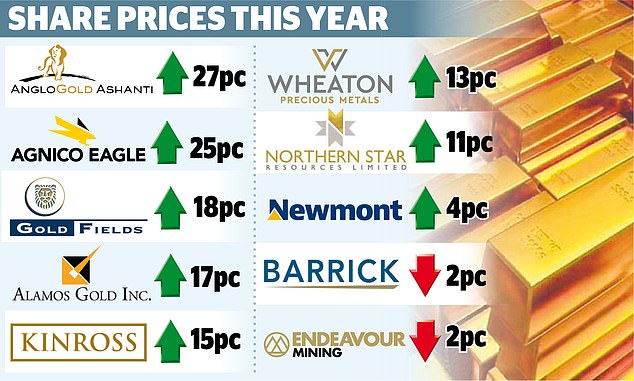Breakfast cereal, detergent and 24-karat gold bars. This may not be your typical shopping list.
But in recent months, thousands of customers of US cash-and-carry giant Costco have been putting one-ounce bars into their carts.
They’re spending up to $200 a month, according to Wells Fargo, a bank created to handle cash flows from the 1849 gold rush.
Hedge funds and central banks in China, Turkey and other countries are also buying, pushing up the price of the metal over the past six months by 20 percent to $2,360.
Gold appears to have assumed its former role as a safe haven and store of value.
So optimistic are the forecasts for further price increases that this latest gold rush seems like a brilliant opportunity.
BHP’s £31bn bid for Anglo-American launched this week also hints at the likelihood of more fun mergers and acquisitions in the metal mining industry.
Citigroup predicts that bullion will “shine like a diamond,” reaching $3,000 within six to 18 months.
Goldman Sachs estimates a price of $2,700 by Christmas, although even at this level gold would still be below its June 1980 all-time high in real terms. When the Soviets invaded Afghanistan, the price reached $850, the equivalent of $3,180 today.
These estimates are based on concerns about growing unrest in the Middle East and the view that inflation has not yet been quelled, especially given spiraling US public debt. Evy Hambro, joint manager of the BlackRock World Mining fund and the BlackRock Gold and General fund, highlights a change in investor preferences.
He says: “People are looking for assets that offer an alternative to cash and, as it is now easier than ever to buy gold, the barriers to entry have been lowered.”
Kate Townsend, of wealth management company IBOSS, also argues that there is a demand for “a long-term diversifier against more traditional assets”.
If you are contemplating a diversification out of gold, you should be prepared for increased price volatility seen this week and be optimistic about the lack of performance. Gold offers no income. The Royal Mint has a range of coins and bars priced from £90.52. They are VAT-free and have a stylish Britannia design.
A share in a gold fund or trust may be less aesthetically pleasing. But you won’t face the problem of insurance or storage.
Gold exchange-traded funds (ETFs) hold bullion in your name. Broker Interactive Investor recommends the iShares Physical Gold ETF in which I have a small amount of money.
Gold mining stocks are worth betting on: the rising price of this metal means that the high production costs of these companies should be covered.
Ole Hansen, head of commodities strategy at Saxo Bank, says: “Shares of gold mining companies are undervalued, offering potential for return on investment.”
Dan Boardman Weston of BRI Wealth Management says: ‘It looks increasingly likely that gold prices will remain elevated and that this will translate into higher revenues and greater profitability for listed gold miners. I would prefer the VanEck Gold Miners ETF. It provides exposure to the largest gold miners such as Newmont, Barrick Gold and Franco-Nevada in several different geographic areas.
Newmont is the largest gold mining group in the world. It made losses in 2023, but this year it is expected to produce 6.9 million ounces of gold, up from 5.5 million last year.
Gold’s resurgence should at least be a stimulus to evaluate your portfolio.
If you have money in two capital protection trusts (Personal Assets and Ruffer), you are already exposed to gold. Their holdings are 12 percent and 8 percent respectively.
Ruffer’s performance has been poor, much to the chagrin of investors like me.
But I am hopeful that the trust’s focus on bullion can reduce the discount, that is, the gap between its shares and their net asset value (NAV), which stands at 7 per cent.
An additional boost may come from the trust’s recent investment in silver, which its managers say “historically lags and then outperforms gold.” Another precious metal you should consider including on your investment shopping list? So it seems.


